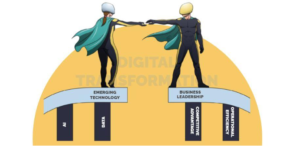In today’s climate it has become more important than ever for businesses to grow and adapt to the digital world. Digital transformation has been a hot topic over the last number of years, but the Covid-19 global pandemic showed us just how essential it is for businesses to develop and prioritise a digital transformation strategy.
How did the COVID-19 pandemic changed digital transformation?
Prior to the global pandemic, digital transformation was often on the boardroom agenda for many businesses though with very little action or urgency to move it along. Once lockdowns and remote working became a requirement however, businesses soon realised that digital transformation was an essential step for their survival.
In the context of remote working, those who had implemented a digital transformation strategy and had their new digital processes in place found the transition to a remote workforce a lot less challenging. Those who had not done so, however, saw a total shutdown of their businesses. Tasks reliant on analogue or paper-based processes could not be performed at home.
This led to a rapid adoption rate of digital transformation not only in large corporations but also in the small and medium enterprise sector. Not only did the pandemic act as a catalyst for this uptake in digital transformation, it also clearly demonstrated the fate that awaits businesses that refuse to adapt to the new digital age.
What is digital transformation?
So firstly, let’s take a look at what exactly digital transformation is. To put it simply, it’s the process of using digital technologies to create new — or modify existing — business processes, culture, and customer experiences to meet changing business and market requirements. This reimagining of business in the digital age is digital transformation.
The Stages of Digital Transformation
As with most large-scale restructuring projects, the idea of undertaking such a feat can seem overwhelming. This is especially true in the case of long-standing businesses that may have 50+ years’ worth of legacy practices to overcome both in the physical work and the mentality of the workers.
For this reason, planning is an essential part in implementing a digital transformation strategy and there are many steps to be taken long before the implementation and rollout stage. Digital transformation can be broken down into 2 key stages as follows:
1. Digitisation
This is simply the process of turning analogue into digital. For example, turning a physical hand-written document into a scanned pdf saved onto the computer. While this may be a long process it is an essential step in the direction of digital transformation. After all, how can you implement a digital process if none of your data or assets are in digital format?
2. Digital Transformation/Digitalisation
Digital Transformation, also known as Digitalisation, is the process of leveraging digitisation through the use of digital technologies to improve your business processes.
For example, the scanned document now in pdf format can then be saved in the cloud, meaning it can be accessed not only from the office computer but any computer with internet access.
From being a paper based hand-written document viewable only in person, to a digital file that can be accessed from anywhere in the world…you can begin to imagine the power that such changes can have in all aspects of a business’s day to day This kind of radical transformation can allow businesses to be smarter, faster, and more responsive to consumer needs than ever before.
The 4 main touchpoints of Digital Transformation
Now that we understand what digital transformation is, let’s take a look at the key areas it affects:
1. Technology
Technology is constantly evolving and rapidly transforming the way that we live and work. From artificial intelligence to the Internet of Things, employees and consumers alike expect a more streamlined and digital experience from the businesses of today.
While adopting new technologies and integrating them with existing workplace systems may be highly complex, they will greatly improve and increase business success. Simply put, if you’re not willing to adapt to the technologies of today your business will quickly feel outdated and may be left in the past.
2. Data
Data has always been a driving force for decision making. Now in it’s digital form and the endless tools available to analyse it – businesses can take a lot of the guesswork out and make more informed strategic decisions.
While the technology is there to help us with the analysis process, it can be difficult to know how to use all of this newfound information. Therefore, it is essential that those who work with it can understand and interpret it correctly in order to undertake a digital transformation successfully.
3. Process
Digital transformation requires a holistic view of business practices in order to fully leverage its potential for your business. By this, we mean you must fully understand the processes currently in place from beginning to end in order to identify what can be digitised and digitalised.
Once you have undertaken an audit of how things run currently across all activities you can begin to plan for your digital transformation. This is an important step as it will allow you to laser target low hanging fruit which can be easily and quickly implemented to see immediate improvements, while also making long term actionable goals towards becoming a modern and successful business of tomorrow.
4. Capacity for Organisational Change
At the heart of a successful digital transformation strategy is the people who work on the business processes day in and day out. It is these people who must be willing to change, grow and adapt the way they do things in order to fully leverage the technologies available to us.
For this reason, buy-in from the people within the organisation is essential for a smooth transition to take place.
Why does digital transformation matter?
If you are wondering if digital transformation is something you should be considering for your business, then the answer is YES.
In the wake of the global pandemic, an organisation’s ability to adapt quickly to supply chain disruptions, time to market pressures, and rapidly changing customer expectations has become critical. In today’s world it has become an issue of survival.
Business spending priorities are reflecting this reality. The International Data Corporation (IDC) reveals 2021 worldwide digital transformation predictions will be 65% of Global GDP digitalised by 2022, driving Over $6.8 Trillion of direct digital transformation investments from 2020 to 2023.
As the data suggests this has become an essential expectation of businesses today and something you should be working towards if you wish to stay relevant in the markets of tomorrow.
Did you know that 70% of businesses fail to successfully digitally transform? Don’t be one of those! Make sure you start your journey on the right path to build and digitally transform your business.
So if you’re ready to kickstart your company’s journey into digital transformation – Contact Us to discuss your options.
(Or if you’re not ready today and want to keep digital transformation in mind for the future sign up to our Newsletter to stay in the know for all the future digital transformation & tech events and courses).



